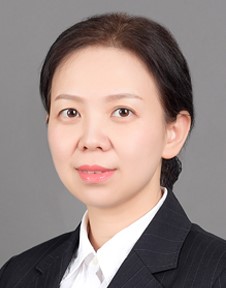Rong Chen
Emerging thin film technology
State Key Laboratory of Digital of Manufacturing Equipment and Technology
School of Mechanical Science and Engineering
Huazhong University of Science and Technology
Wuhan, Hubei 430074, P. R. China
Email: rongchen@mail.hust.edu.cn
Biography
Dr. Rong Chen, Professor with the School of Mechanical Science and Engineering, and by courtesy of School of integrated circuits, school of optical and electronic information, and School of China-EU Institute for clean and renewable energy, Huazhong University of Science and Technology (HUST). Assistant to dean and Associate director of HUST flexible electronics research center.
Prof. Chen obtained her bachelor degree from University of Science and Technology of China (USTC) in 2001 and her Master and PhD degrees from Stanford University in 2006. Before she joined HUST as a full professor in 2011, she was a senior research scientist in Intel Labs and Applied Materials, Inc., Santa Clara, performing R&D in VLSI processes and related equipment development.
Prof Chen’s research focuses on atomic level manufacturing, by understanding surface science, and applying this knowledge to a range of problems in sustainable energy, semiconductor processing, and nanotechnology. Her current research interests include selective atomic layer deposition method, nanoparticles modification, thin film technology for applications in optoelectronics, flexible electronics, catalysis and energy storage, as well as developing ALD apparatus for these emerging applications. Prof Chen is the PI for the key project of national natural science foundation of China, National Basic Research Program of China (973), Innovation team leader of Hubei Province, etc.
Prof. Chen has authored and co-authored over 150 peer-reviewed journal papers and conference proceedings with >4,000 citations on Nat. Comm., Adv Mater, Angew. Chem. Int. Ed, Small, Engineering, Sci. Bullet., IJEM, OEA, etc. She has published three edited books and two book chapters, >70 issued Chinese invention patents and >10 international patents, designated project leader and convenor for ISO/TC 107 WG5 of atomic layer deposition. She has given dozens of invited presentations, lectures and tutorials at international conferences such as IEEE Nano, AVS-ALD. She has served as a committee member of AVS ALD, Asian ALD, and member of EU HERALD. Prof. Chen is a Senior Member of IEEE, life member of ECS, and member of AVS, ACS, etc. She is the Editor for Physica B: condensed matter, corresponding expertise of Engineering, and the Editor Board Member for five scientific journals: JVSTA&B, IJEM, coatings, and scientific reports. She also served as Guest Editor for four journal special issues, Chair or Committee Member for >60 international conferences, Reviewer for >60 prestigious journals including Nat. Catal., Nat. Commun., Adv. Mater., Adv. Funct. Mater., ACS Nano, Small, Chem. Mater., Nanoscale, Engineering, light, APL, J. Appl. Phys., Appl. Surf. Sci., RSI, JVSTA, etc.
Prof. Chen is the recipient of many national and international prestigious awards, including National innovation leader (2019), National overseas high-level young talents (2011), the 3rd Xplorer prize (2021), China Overseas innovation talents contribution award (2016), etc. She is also the recipient of IEEE SEC Distinguished Academic Contribution Award (2020), Geneva international innovation exhibition Special Gold awards (2018), the SRC Simon Karecki (2006), the Texas Instruments Woman’s Fellowship for Leadership in Microelectronics (2005). She has been ranked first for the first prize of Technological invention of Hubei Province (2018), Intellectual Property Award of Hubei Province (2019), CAST “Innovation China” leading technology (2020), winner of the MOST disruptive technology innovation competition (2021), etc.
Abstract for Presentation
Atomic layer deposition enabling bottom-up manufacturing to extend Moore’s Law and beyond
Moore’s law drives the semiconductor industry to continuously shrink the critical size of transistors, however, the current fabrication processes still have challenges in future downscaling. Meanwhile, flexible, wearable and smart devices have been embedded into daily life, more functional devices with integrated types of sensors, circuits and various functionality are needed. Thus, newly-developed bottom-up schemes are believed to be necessary manufacturing methods combined with the top-down approaches. Atomic layer deposition (ALD) provides high accuracy with nanometer or close-to-atomic scale to fabricate nanostructures.[1] Firstly, the downscaling of transistors drives the selective deposition of dielectrics and metals for alignment. Various template-assisted selective deposition methods, e.g. self-assembled monolayers, have been utilized for the alignment of 3D complex structures. Furthermore, the inherently selective deposition depends on initial nucleation control rather than relying on introducing inhibitors and removing steps will be presented.[2] The fundamental mechanism lies in tuning the chemical thermodynamic and kinetic differences. More selective approaches based on nucleation control which is highly related to the surface reaction, such as tuning the substrates electronegativity, alkalinity or acidity are also developed.[3] Besides, there are increasing demands for the flexible electronics. The mechanical adaptation with bending resistance, stretchability is essential. Inserting with reverse stresses layers through ALD can release the total stress of the stacking films, and suppress the delamination and cracking from the interfaces.[4] Alternating inorganic-organic nanolaminate packaging structures can be incorporated into the encapsulation layers, which significantly improve the flexibility.[5] For future nanomanufacturing, ALD is still evolving to expand its abilities, providing a window of opportunity for large scale atoms integration that is an enabling technique to future applications such as quantum computing, single atom transistors etc.
References
[1] R. Chen, Y. C. Li, J. M. Cai, et al. Inter. J. Extreme Manufacturing 2020, 2, 022002.
[2] K. Cao, J. M. Cai, R. Chen. Chem. Mater. 2020, 32, 2195
[3] Y. C. Li, K. Cao, Y. X. Lan, et al. Molecules 2021, 26, 3056
[4] Y. Li, K. Cao, H. Z. Yang, et al. Adv. Mater. Interfaces 2020, 2000237.
[5] Y. Li, Y. F. Xiong, W. R. Cao, et al. Appl. Mater. Interfaces 2021, 8, 2100872
WELCOME TO CHINA TO ATTEND THE ICANS
23-26 August, Nanjing, China
Connect with us:



